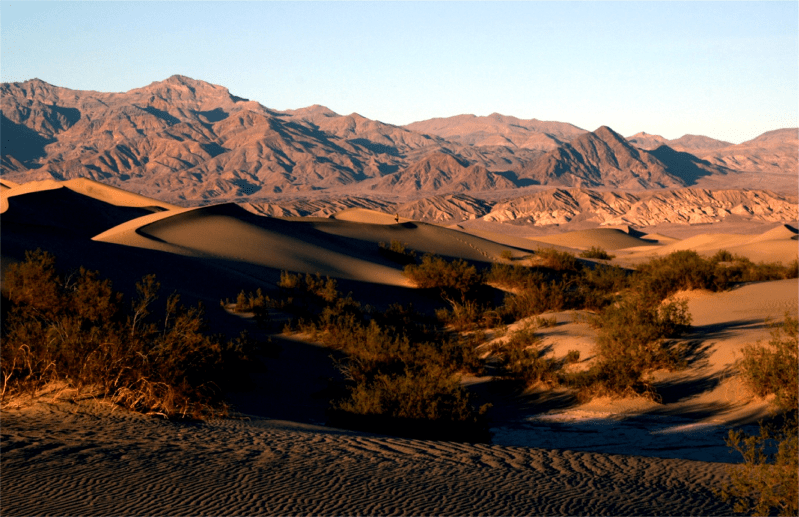
Death Valley Facts
- The term Death Valley serves as the name of a severe desert valley. In addition, this marvel of Nature is located in an entirely surprising part of the world. That holds true because it formed in what’s now Eastern California, in the United States.
- Its unique geology helps to make it one of the most astounding of such sites in the world. This makes it the driest, lowest, and hottest region found in North America. This stunning location itself contains features completely unique to this part of the globe.
- Among them sits an area that holds a warm place in the record books. That’s the highly appropriately named Furnace Creek. That’s due to the fact that, in this location, in 1913, the highest air temperature ever recorded was reached; 134 F (56.7 C).
- Yet another feature found within the amazing Death Valley holds a prominent position, at least in scientific circles. This region is known by the unusual name of Badwater Basin. It has the lowest elevation in North America, at 282 ft (86 m) below sea level.
- Its frequently dangerous, but still stark, beauty, also served it well. The desert region currently forms the cornerstone of the remarkable Death Valley National Park. This, in turn, comprises part of the Mojave and Colorado Deserts Biosphere Reserve.
Related Articles
Sahara Erg Chebbi Salar de Uyuni
Death Valley Geology
Death Valley remains considered to be one of the finest examples of its type of feature in the world. The area classifies among scientists as a basin and range configuration. The incredible area also sits at the extreme southern end of a trough known as Walker Lane.
This trough, itself quite impressive, proceeds north into the state of Oregon. The magnificent valley also remains bisected by a slip fault system. Furnace Creek also flows into the remarkable valley. Eventually, however, this dries up in the sands of the valley floor.
Quite noticeably, extensive areas of sand dunes also cover large portions of the Death Valley. In addition, numerous features known as salt pans are also located in the region. These form the remains of several inland seas that were present during the Pleistocene era.
The evaporation of these ancient seas also left behind an extremely impressive natural legacy. Their departure deposited large quantities of sodium and borax This long-term process also left behind large quantities of the minerals sodium and borax.
Death Valley Climate
The astounding feature aptly known as Death Valley fully earns its name. That’s due to the fact that it possesses a quite extensive subtropical, hot desert climate. This climate remains categorized by its long, extremely hot summers, followed by very short warm winters.
Rainfall also remains scarce and sporadic throughout the entirety of the region. More precisely, such moisture continues to be virtually non-existent in some portions of the site. Also, when the sun heats the air, what little does arrive evaporates with extreme speed.
The high valley walls also help add to the arid climate of the region. These structures efficiently serve to circulate the hot air back down to the floor of the valley. There it quickly becomes heated to even higher temperatures by the process of compression.
In addition to this, yet another condition adds to the situation. The density of the below sea level air further augments the already powerful process. It accomplishes this by reflecting even more of the already overwhelming heat downwards, back into the valley.
Death Valley Phenomenon
Death Valley also serves as home to a unique phenomenon that had baffled scientists since the 1940’s. Many referred to this as the sailing stones. In a remote region of the valley, known as Racetrack Playa, numerous stones of varying sizes litter the sandy floor of the playa.
Over the decades many of these stones appeared to move, leaving tracks in the sand. These also left behind no apparent explanation. Finally, in 2014, a team of researchers managed to catch the phenomenon in Death Valley in action, and explain it.
Under a rare and unique combination of conditions during the winter, thin sheets of ice form on the floor of the playa. Winds drive the stones slowly across the playa floor, as the ice also breaks up. The process also occurs rarely, and too slowly to be viewed by the naked eye.
Features Sharing Its Range
McWay Falls New Year’s Island Alamere Falls
Check out our other articles on 6 Extraordinary North American Reptiles, Goblin Shark, Jeju Island, Hammer Orchid, African Manatee, Calleta silkmoth, Common European Viper

